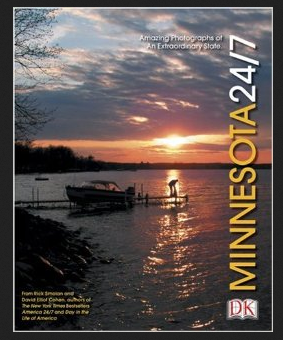From the foreword to Minnesota 24/7: Extraordinary Images of One Week in Minnesota 
Lieutenant Zebulon Pike was sent by the United States of America to find out what the nation had bought into up at the top end of the Louisiana Purchase. After Lewis and Clark traveled up the Missouri River in search of a northwest passage, Pike went north, up the Mississippi River, where he bought a chunk of land from the Dakota Indians at the confluence of Mississippi and a river the Indians knew as “the river that is the color of the clouds.”
“Minnesota” is the name that eventually settled on the river and the place. There have been claims over the years that it means Land of Sky Blue Waters (you may remember the beer commercials). But any true Minnesotan knows there is more than a little Paul Bunyan tall-tale telling and a lot of wishful thinking in that blue-sky stuff. If there is one thing that defines Minnesota, it is a perverse pride in the vigor it takes to live in a northern place where beauty and harshness have equal weight.
We are 400,000 deer hunters, one million anglers, five million Vikings fans, and 15,000 lakes (10,000 sounds better on a license plate). We are the state of 3M and 3S’s too: Schools, Science, and Spirituality. A place where public colleges and private institutions, from the University of Minnesota to the Mayo Clinic, have worked in a progressive political tradition to make a state that isn’t just at the top of the Mississippi but at the top of the country.
A state of hockey, of Herb Brooks and 12 gold-medal winners on the 1980 Olympic hockey team still enshrined in our hearts. A state of turkeys and soybeans and sugar beets and corn. Of the rugged Lake Superior shore, the pristine headwaters of the Mississippi, and the sprawling energy of the Twin Cities. Of Hubert Humphrey, Walter Mondale, and Jesse Ventura. Sinclair Lewis, F. Scott Fitzgerald and Al Franken.Charles Lindbergh, Judy Garland, and the World’s Largest Twine Ball.
Whether we can keep it going sometimes worries us. We’ve had our share of budget woes, spending cuts, and political squabbling. We’ve had our resilience and our resources tested by newcomers fleeing wars in Africa and Asia, or fleeing the misery of failed urban areas elsewhere, each of them attracted to a quality of life we like a lot but sometimes don’t feel like sharing.
But we will share. It’s in our nature. We’re good hosts.
Maybe we’re still embarrassed that old Zebulon Pike didn’t stay long. He came in September of 1805, shot down a Union Jack he found flying over a British fort, and by February had had his fill of the Minnesota winter. Pike skedaddled back down to St. Louis.
Today’s Minnesotans are made of sterner stuff.
As you will see in the pages of this book, the people of the North Star State are its most precious resource. From the Indian tribes whose languages shaped the Minnesota map to the Scandinavian, German, and Yankee stock that made Minnesota into a remarkably welcoming place that has opened its arms to Hmong, Somali and Latino newcomers, Minnesota is renewing its potential and rediscovering its riches: Its people.
Did I mention our fabulous blue skies?
—Nick Coleman is a writer in St. Paul
